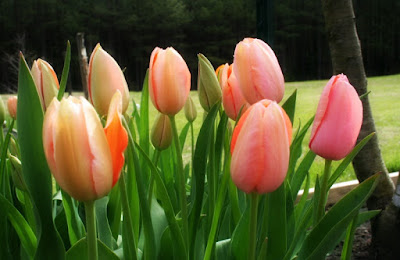Tulips may be a sign of spring, but they are actually planted in the fall in anticipation of spring. The bulbs require several weeks of chilly weather in order to grow and bloom. Now is the best time to shop for tulip bulbs. The local nursery and garden centers have the best selection, and you can take your time picking the best of the bunch for your garden.
Tulip bulbs actually hail from Turkey and cooler Asian climates. Traders brought them to Holland, where they seemed to flourish in the cool, moist climate. By around 1637, tulips were all the rage, with new colors like the "Rembrandt" striped and striated flowers causing a run on the market, with prices soaring in a short while. Fortunes were made and lost as speculators bid their wealth on the precious bulbs. Sound familiar? People never change!
Today, we are fortunate to live in an era when hybridizers and growers have selected the best among each of the categories of tulips and bred them for specific characteristics such as color, resistance to wind and weather, repeat blooming and so on.
Most tulips should be treated as annual flowers, or at best, short-lived perennials. Although I have some Darwin hybrids (above) that return in the garden, with each year they do diminish, and eventually the flowers are much smaller than in their original years. The plant puts energy into the bulb to reproduce, and eventually, unless you dig up the bulbs, split them, and lovingly tend them for a few years, they won't bloom again.
Gardeners, myself included, rarely have the time, patience or space for this, so I simply plant more and enjoy the show.
 |
If you're interested in naturalizing with tulips, or finding tulips that might return for repeat blooms, choose from among the Tulipa kaufmaniana, Tulipa fosteriana, and Tulipa gregii hybrids. Like species tulips, these tend to bloom earlier and are less showy than the cottage, Darwin, parrot and lily-flowered tulips that add so much variety to the garden.
As you shop for your tulip bulbs, read the package label. Consider the estimated blooming times, and add a few species that bloom as early as March and as late as May so that you have a continual show in the garden. You can plant different species in the same planting hole. The tulips don't mind.
Choose the biggest bulbs you can find. The larger the bulb, the bigger the flower - or at least that is what a Dutch bulb grower once told me when I worked in a garden center! And after your tulips are finished blooming in the spring, let the leaves die back naturally. Don't cut them back or hack them down to the ground. The leaves are the food factories of the plant. Through the process of photosynthesis, they produce carbohydrates in the leaf cells which act as nourishment for the plant. Cut the leaves off of the plant and it dies.
Lastly, as you're planting tulip bulbs, remember to plant them with the pointy-side up, like a Hershey's chocolate kiss. Dig the hole as deeply as the package directions tell you to do, for the plant needs it, and the deeper holes discourage squirrels from digging the bulbs up entirely. Make sure you place a plant label or a marker on the spot so that you remember what you've planted there. It's easy to forget during the long winter months and dig up your precious bulbs in your haste to plant spring annuals later.
Although I don't think we'll see "Tulipamania" the way the Dutch did during the Dutch Golden Era, I sometimes feel a kinship with the burgermeisters of times past who gambled fortunes on flower bulbs. As I empty my wallet on the store counter, packing bag after bag of tulips away as if they were treasures of gold, I understand how one humble flower could inspire a mania. I share the passion!
RESOURCES for Your Enjoyment




